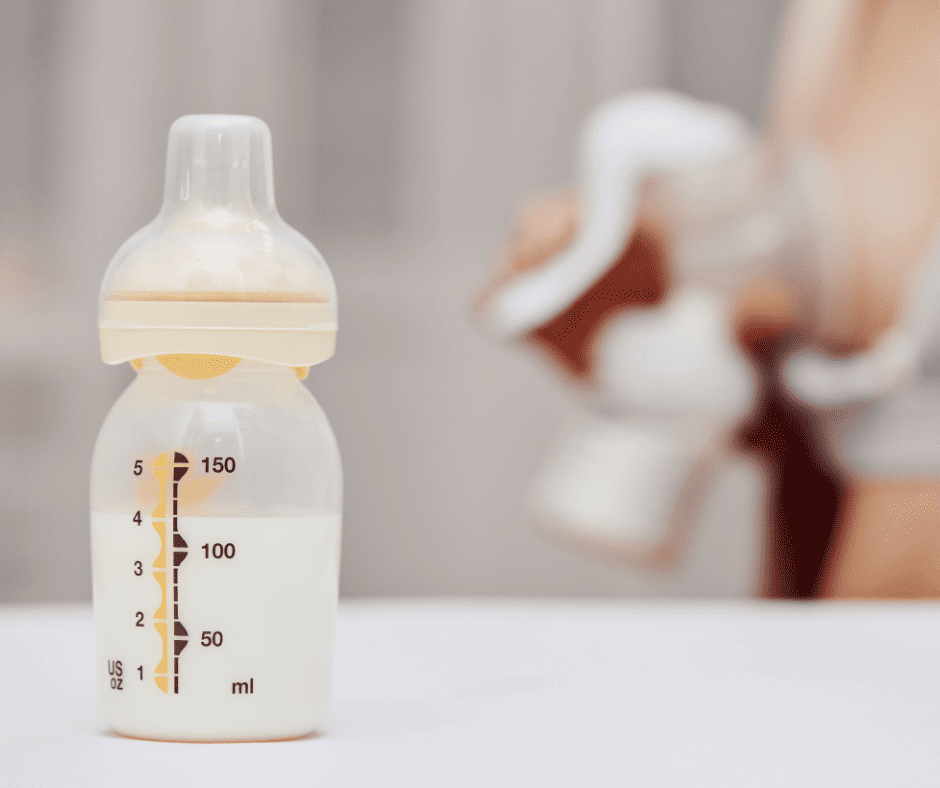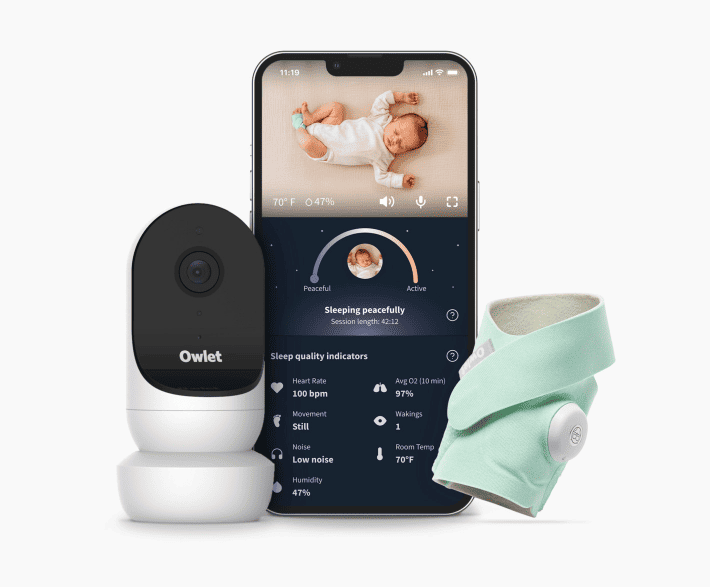Wondering about getting more rest as a breastfeeding mom? One major concern that a lot of new mamas have is that they desperately want to breastfeed, but they also need sleep. We know that sleep is super important to mental health and just functioning day-to-day! But, we also know that newborns have to be fed eight times in a 24-hour window. If we divide that by 24 that’s every three hours! This oftentimes leaves moms completely exhausted and feeling like they are not able to function. Don’t worry, there are sleep solutions for nursing moms!
I have found the trick to getting mamas more sleep at night while also dealing with milk supply management.

How Breastfeeding Works: Supply And Demand
Having a good milk supply is all about supply and demand. “…the more your baby feeds, the more breast milk you’ll produce…so if you’re feeding hours apart, you may start producing less milk,” explains the NHS. You have to get a certain number of stimulations (milk removal) per 24 hours to put in an order for your body to make more milk.
There are different types of stimulations:
- Breastfeeding
- Hand expression
- Electric pump
Tip: Did you know that you can order your breast pump through insurance? Even if you don’t think you’ll use one, get one! Babylist Health will take care of contacting your provider and insurance. Sign up today!
“Your baby should be ready to begin feeding from birth. The active trigger of him latching on and sucking rhythmically helps to ‘switch on’ your milk-producing cells and initiate the supply of your first breast milk, colostrum,” tells Medela. Get the free video course, Birth Made Simple, to find out more about yourself and your baby in those fresh 48 hours postpartum.
In the first two weeks, you are in the transition phase of breast milk production. This transition is called lactogenesis 2. What this means is that your body is transitioning from colostrum to making more mature milk. “Mature milk is the final milk that is produced. 90% of it is water, which is necessary to keep your infant hydrated. The other 10% is comprised of carbohydrates, proteins, and fats which are necessary for both growth and energy,” explains the American Pregnancy Association.
The demand that you put in for breast milk is going to help set you up for a healthy breast milk supply throughout your entire breastfeeding journey.

How Many Times Should Your Breast Milk Be Removed?
Typically, moms want to know: How many times do I have to have milk removal in those first two weeks to really make sure that I have an adequate milk supply? The short answer is at least eight times, but really eight to twelve times in a 24-hour window is more normal for the majority of moms depending on the size of their baby.
A baby that weighs five to six pounds is only going to be able to take a smaller volume per feed. If you have a nine to 10-pound baby and you’re really only producing one to two ounces in the first week, that baby is going to need more volume per 24 hours to grow. So, you’re going to have to feed more often until your body catches up and you have a supply that matches your baby’s need.
During the first two to four weeks you’re in the building phase of breast milk production and the supply and demand is still super important. Once you are past the first four weeks postpartum, you’re in the maintenance stage of breast milk production.
Eating a nutritious diet and staying hydrated are also important aspects of ensuring a healthy breast milk supply. According to Parents, “Choose meals heavy on fruits and vegetables, whole grains like brown rice, foods rich in omega-3s like salmon and flaxseeds, and vegetable proteins.”
Why Your Breast Milk Supply Decreases
There could be a few reasons behind a drop in breast milk, including not removing enough milk:
Less Milk Removal
If you give your baby a bottle and you don’t remove your breast milk, then your body thinks, “Oh it’s been X amount of hours without a feeding”.
Let’s say you breastfed your baby at 12 pm and then gave them a bottle at 3 pm; at 5 pm you breastfeed again. Your body thinks that your baby just went five hours without a feed. That’s where supply and demand starts to become an issue.

You may experience engorgement, “Engorged breasts feel like they’re ready to burst. They may feel hard like rocks and so tender that it hurts to walk or change your clothes. Your breasts will feel heavier, and simple things like snuggling your baby may be extremely painful,” says Cleveland Clinic. This is your body’s way of saying, “I don’t need this milk so I can cut back supply.” If you’re not getting the milk removed in that five-hour interval, then your body will start making less milk.
Inadequate Sleep For New Moms
Lack of sleep can contribute to a drop in milk supply. “Postpartum fatigue and a lack of energy can interfere with breastfeeding, and it’s one of the common causes of a low supply of breast milk,” says Very Well Family. We know that if we can get mom a good four-hour stretch of sleep (one REM cycle) then she’s going to feel instantly better and more able to cope with her newborn’s feeding schedule. This is why prioritizing sleep while breastfeeding is essential.
Illness
Maternal health matters! If you’re feeling ill or rundown, your milk supply can be affected. “If you’re fighting an infection, your body may not have the resources it needs to produce your normal milk supply…Additionally, certain medications (e.g., Sudafed and some types of birth control) can reduce your milk supply,” explains Healthline.

Maintaining Milk Supply Through Sleep
To do this, you’re going to trick your body into thinking that your baby is feeding at a closer interval than your baby actually is. Here’s what to do:
Breastfeed your baby around 8 pm. When they fall asleep at around 9 pm, you’re gonna tag someone else in – your partner or another family member or a night nurse – and they’re going to be responsible for the baby.

I highly recommend the new Owlet Dream Duo for baby sleep. It combines the Dream Sock and Cam 2. It’s the only monitor to track heart rate and oxygen as Sleep Quality Indicators, all while streaming HD video right to your phone. Predictive Sleep Technology automatically tracks your baby’s sleep and wake windows, and the Dream App will let you know when they might be ready for sleep before they’re overtired.
Tip: Whoever is doing nighttime feedings with your baby, make sure that they’re doing paced bottle feeding. “Paced feeding lessens the flow of milk and allows for babies to take breaks in between sips. This more closely mimics the stop-start motion that infants use while breastfeeding,” says What To Expect. As a Lactation Consultant and Feeding Specialist, I can tell you with confidence that Dr. Browns Bottles with a level Premie flow nipple is the best bottle for your newborn baby. It’s the only bottle I’ve ever personally used with my 4 kids!
Between 9 pm and 9:30 pm, you’re going to pump. The key here is that you have at least a 60 to 90-minute window from the start of the feed or pump to the start of the next feed or pump.
We’re tricking your body into thinking that your baby is cluster feeding, “Some babies may feed as often as every hour at times, often called cluster feeding,” says the CDC. You’re putting in that demand, you’re removing a few ounces of milk, and you’re getting the stimulation to make your body think that your baby is feeding again.
After that, you’re going to sleep in your protected sleep space that your baby is not in. You’re going to get a good solid four-hour stretch of sleep after that pumping session.

When the person you’ve tagged in has given your baby a bottle, changed them, burped them, and put them back to sleep, they can put the baby into your protected sleep space in a bassinet.
By 12:30 am, you’ll wake up to feed your baby. Typically I do not recommend waking a baby for a nighttime feed when they are past their birth weight and past those first two weeks of life. However, in this certain scenario in the first couple weeks of life, this would be where I would say you can make the choice between pumping and breastfeeding.
Six weeks into your postpartum journey, you can start to match up to what your baby’s doing. Then you’ll have a little bit more wiggle room and you could try a five to six-hour stretch of sleep.
Navigating life with a newborn can be challenging, especially when it comes to their sleep-eat-wake cycles. Download our free guide to getting your newborn to sleep longer here.




